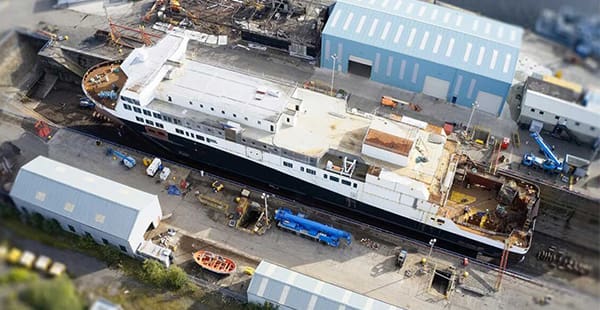01. History
Puget Sound Naval Shipyard History
The U.S. Navy has owned and operated Puget Sound Naval Shipyard since 1891. The shipyard’s history of construction, repair and deactivation work overlaps with a period of widespread asbestos use in the U.S. Until the 1980s, the Navy commonly opted to use asbestos and even required its use in some cases. Asbestos causes mesothelioma and lung cancer. Navy personnel and others who worked around the mineral may develop these serious illnesses.
Originally, the Puget Sound Naval Shipyard operated as a ship repair site. During World War I, operations shifted to construction. Workers made submarines, minesweepers, ammunition ships and small boats. During World War II, the shipyard mainly repaired ships in the Pacific Fleet. It also activated and deactivated ships during the Korean War.
In the 1960s, Puget Sound Naval Shipyard constructed a number of new buildings on-site. This was a time when using asbestos construction materials in industrial building projects was common.
In the 1990s, the Environmental Protection Agency (EPA) designated Puget Sound Naval Shipyard a Superfund Site. The agency mentioned asbestos as one of its environmental concerns, including exposed asbestos bricks on-site. Cleanup began in 1997. In several areas of the shipyard, cleanup efforts are ongoing.
Today, the shipyard provides maintenance and recycling services for surface ships and submarines.
Puget Sound Naval Shipyard History at a Glance
- Other Names: Puget Sound Naval Shipyard and Intermediate Maintenance Facility, Navy Yard Puget Sound
- Location: Bremerton, Washington
- Owner(s): U.S. Navy
- Years of Operation: 1891 – Present
- Wartime Operations: World War I (WWI), World War II (WWII), Korean War
- Size of Shipyard: 380 acres
- Noteworthy Ships: USS Constellation, USS Kitty Hawk, USS Sculpin
- Types of Ships Built/Serviced: Ammunition ships, carriers, frigates, minesweepers, submarines, tugboats
Workers at Puget Sound Naval Shipyard faced asbestos exposure risks. Their loved ones may have also experienced secondhand exposure. People who develop an asbestos-related disease may be eligible for compensation.
Notable Ships Built and Repaired
For over a century, Puget Sound Naval Shipyard has built, repaired and decommissioned ships. It is the Pacific Northwest’s largest Naval shore facility. Major ships were built, maintained and recycled by workers at the shipyard.
USS Constellation (CVA-64)
The USS Constellation was built in 1957. Workers at Puget Sound Naval Shipyard worked on two major overhauls of the ship, in 1974 and 1983. By the 1980s, the Navy had begun phasing out asbestos use. But during the 1970s, asbestos was a common part of many aspects of shipbuilding.
The ship was an aircraft carrier. It was often referred to by its nickname, Connie.
Puget Sound Naval Shipyard’s 1974 overhaul of the ship was one of the largest ever undertaken. The project enabled the ship to carry the F-14A Tomcat, a type of fighter plane, and the S-3A Viking, a submarine hunter. The 1983 project also involved modifying the ship to carry a new fighter plane.
USS Kitty Hawk (CVA-63)
The USS Kitty Hawk was built in 1956 by the New York Shipbuilding Corporation. In 1964, the Puget Sound Naval Shipyard worked on a major overhaul of the ship. In the 1960s, asbestos use was a common part of the shipbuilding process.
The USS Kitty Hawk was an aircraft carrier. The 1964 overhaul at Puget Sound Naval Shipyard cost more than $14 million. The shipyard was also the designated home port for the USS Kitty Hawk various times throughout the 1960s to the 1980s.
In 2009, Puget Sound Naval Shipyard decommissioned the ship.
Resources for Mesothelioma Patients
02. Asbestos Use
Asbestos at Puget Sound Naval Shipyard
Much of Puget Sound Naval Shipyard’s work on vessels occurred when U.S. asbestos use was at a high. Until the 1980s, the Navy used asbestos for its durability and heat and fire resistance. The mineral was especially common to insulate products subject to high temperatures.
Asbestos products used at shipyards include ship components like boilers, pumps and turbines. On-site facilities may also contain asbestos construction materials. For example, at least one section of Puget Sound Naval Shipyard has structures with asbestos bricks.
Asbestos Exposure at Puget Sound Naval Shipyard
Military personnel and civilian workers faced occupational asbestos exposure risks at Puget Sound Naval Shipyard. People who experience asbestos exposure can develop asbestos-related diseases.
In the past, building ships used many products that could release fibers into the air during application or cutting. Others may have released fibers due to wear and tear. Repair and maintenance also come with risks of handling old asbestos materials. These materials may still be present in older ships or buildings on the jobsite.
03. Lawsuits
Asbestos Lawsuits and Settlements for Puget Sound Naval Shipyard
People diagnosed with mesothelioma may be able to seek compensation from companies that supplied asbestos to the Navy. Settlements and lawsuit verdicts from these companies average over a million dollars. This money can help patients pay for medical costs and other expenses related to their diagnoses.
Veterans and workers can speak to an attorney to file lawsuits. A specialized asbestos attorney can help identify potential sources of exposure at Puget Sound Naval Shipyard.
04. Trust Fund Claims
Asbestos Trusts Associated With Puget Sound Naval Shipyard
Asbestos companies continue to face legal consequences for using this dangerous mineral. Some have been unable to meet their liabilities and have filed for bankruptcy. This includes several companies that provided asbestos products to Puget Sound Naval Shipyard.
Bankrupt asbestos companies have set up trust funds to compensate current and future victims. A mesothelioma lawyer can help identify asbestos trust funds to file with. Once identified, the lawyer can file on behalf of their client.
Filing asbestos trust fund claims does not mean victims cannot also file lawsuits.
Asbestos Trust Funds and Eligible Years of Employment
Asbestos trust funds have eligibility requirements for filing with them. A mesothelioma lawyer can determine eligibility based on a victim’s work history and other factors. Companies listed below have trust funds and are known to have supplied asbestos products to Puget Sound Naval Shipyard.
| Asbestos Trust Funds & Eligible Years of Employment | ||
|---|---|---|
| Asbestos Company Name | Eligibility Start Date | Eligibility End Date |
| AC&S Inc. | 6/10/1972 | |
| Babcock & Wilcox | 1/1/1902 | 12/31/1982 |
| Combustion Engineering | 12/31/1982 | |
| Eagle-Picher | 12/31/1972 | |
| Fibreboard | 1/1/1941 | 12/31/1982 |
| Flexitallic | 1/1/1941 | |
| Halliburton | 9/29/1938 | 12/31/1982 |
| Keene Corp. | 1/1/1940 | 12/31/1981 |
| Narco | 1/1/1966 | 3/31/1973 |
| Owens Corning | 1/1/1941 | 12/31/1982 |
| Pittsburgh Corning | 1/1/1964 | |
| Plant Insulation | 1/1/1948 | 12/31/1999 |
| Turner and Newall | 1/1/1950 | 12/31/1982 |








